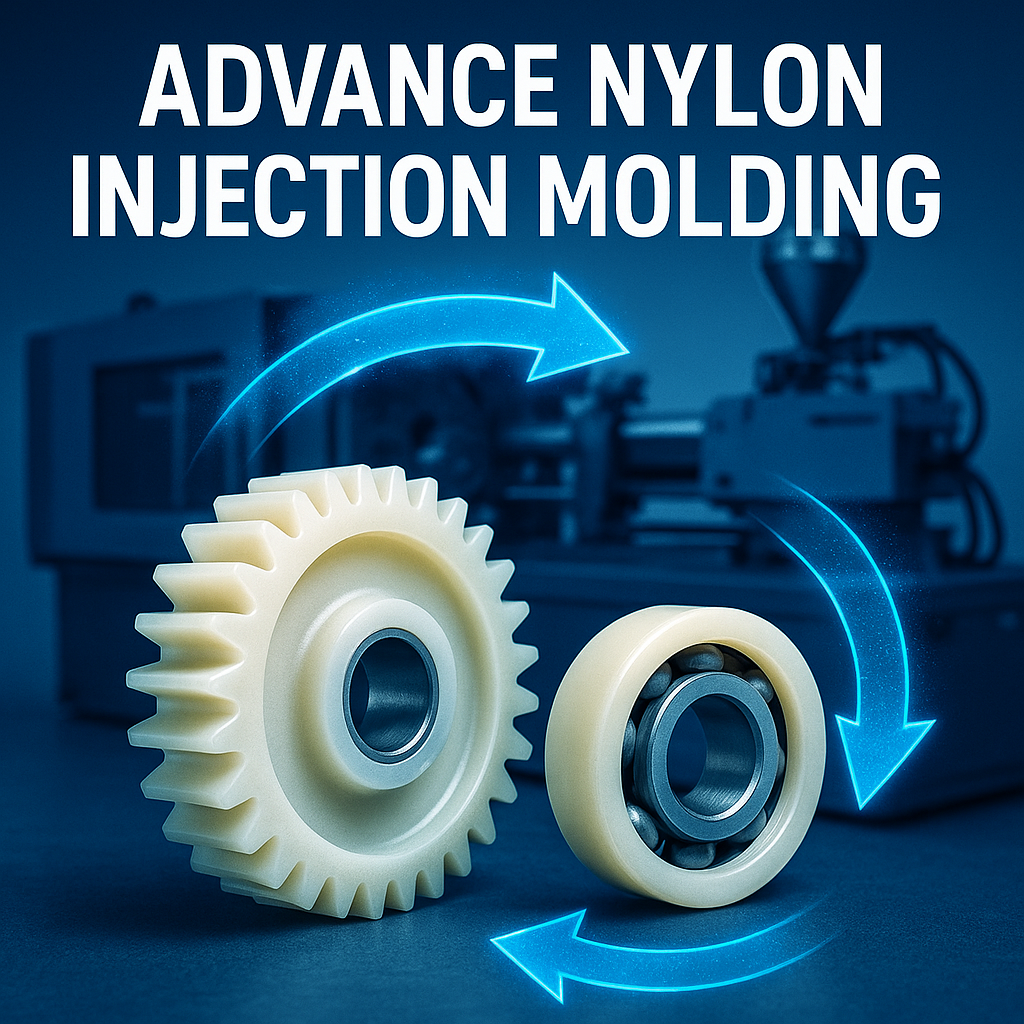Advance Nylon Injection Molding to Boost Wear Resistance and Component Longevity
Advance Nylon Injection Molding to Boost Wear Resistance and Component Longevity
Nylon (polyamide — PA) has long been the workhorse resin for gears, bearings, and structural parts that face constant friction. Yet a standard PA 6 or PA 66 formulation—processed with off-the-shelf parameters—often leaves performance on the table. By advancing nylon injection molding through smarter material selection, additive packages, and optimized processing, you can elevate wear resistance, extend service life, and reduce field failures—without breaking BOM budgets.
1 Why Nylon Is Already a Wear-Fighting Champion
| Property | Nylon Advantage | Practical Impact |
|---|---|---|
| High crystallinity | Creates tough micro-structure | Resists surface micro-pitting |
| Low friction coefficient (≈ 0.25 dry) | Naturally self-lubricating | Less need for external greases |
| Excellent fatigue strength | Withstands cyclic loading | Ideal for gears, cams, hinges |
| Good heat tolerance (up to 120 °C for PA 66) | Maintains hardness under frictional heat | Slower wear at contact points |
Still, native nylon absorbs moisture, can creep under load, and eventually scuffs. Advancements close these gaps.
2 Material Levers to Push Wear Resistance Further
-
Reinforcement Fibers
-
Glass Fiber (10–35 %) – Multiples tensile strength but may raise friction against metal mates.
-
Carbon Fiber (15–40 %) – Boosts stiffness and heat conductivity, dissipating friction heat fast.
-
-
Solid Lubricant Fillers
-
PTFE (5–15 %) – Lowers surface energy; ideal for sliding gear pairs, reduces squeak.
-
Molybdenum Disulfide (MoS₂, 1–5 %) – Adds micro-scale lubricity and dark coloration that hides wear tracks.
-
-
Impact Modifiers
-
Elastomeric rubbers blended at 5–15 % absorb shock loads, slowing micro-crack initiation.
-
-
Heat-Stabilizer Packages
-
Copper-based or hindered-phenol systems scavenge free radicals, preserving polymer chains during long-term friction heating.
-
-
Hydrolysis-Resistant Grades (PA 6T, PA 9T)
-
Aromatic backbones shrug off high humidity or glycol coolant splash—key for automotive pump components.
-
Tip: Always validate tribological data (PV limits, wear factor K) from the producer—not just tensile modulus—when comparing grades.
3 Mold Design & Processing Tweaks That Matter
| Process Area | Advanced Practice | Wear-Life Payoff |
|---|---|---|
| Gate Design | Edge gates for fibers-in-flow orientation; pinpoint gates for cosmetic wear strips | Aligns reinforcement along stress path, lowering abrasion |
| Melt Temperature Control | 10–15 °C above nylon’s melt peak to ensure complete flow but avoid degradation | Reduces voids that become crack nuclei |
| Mold Temperature (80–110 °C) | Promotes higher crystallinity and surface hardness | Less micro-pitting under load |
| Packing & Holding Profile | Graduated pressure to densify gate region | Minimizes sink that acts as wear pocket |
| Post-Mold Annealing | 120–140 °C for 4–6 h on thick parts | Adds up to 20 % extra crystallinity, boosting abrasion resistance |
4 Designing for Durability — Five Engineering Guidelines
-
Uniform Wall Thickness — avoids hot spots where chain scission accelerates wear.
-
Fillet Corners ≥ 0.5 × wall — spreads bearing loads, reducing edge chipping.
-
Integrate Lubricant Grooves — capture PTFE debris as self-renewing lube film.
-
Metal Inserts with Knurl or Undercut — prevents micro-slip that produces fretting wear.
-
Moisture-Condition to 1.5–2 % — controlled humidity soak toughens parts before field use.
5 Real-World Results — Case Snapshot
| Metric | Standard PA 66 Gear | Advanced PA 66 + 15 % PTFE + 35 % GF Gear |
|---|---|---|
| Dry Wear Rate (mm³/ N·m·h) | 1.1 × 10⁻⁴ | 3.2 × 10⁻⁵ (-71 %) |
| Noise (dBA @ 3 000 rpm) | 78 | 71 |
| Field Replacement Interval | 18 months | 48 months |
| ROI vs. Standard Grade | — | 3.4× in maintenance savings |
6 Why TaiwanMoldMaker.com Partners Excel in Advanced Nylon
-
Materials Access: Distributors stock specialized PA 6T, PA 46, and PTFE-filled masterbatches locally, eliminating 6-week overseas waits.
-
Fiber-Sensitive Tooling: High-speed CNC & texturing know-how create wear-optimized cavity surfaces that won’t shred glass fibers.
-
Scientific Molding: RJG-certified processors tune V/P switchover, cavity pressure, and cooling symmetry—documented with real-time eDart traces.
-
Collaborative DFM in English: Engineers fluent in gear standards (DIN 3990, AGMA 2001) shorten iteration loops.
7 Implementation Roadmap
-
Define Wear Profile – torque, sliding speed, counter-surface.
-
Select Candidate Nylon Grades – shortlist 3 with proven Ka, PV data.
-
Run Moldflow with Fiber-Orientation Module – predict stress hot spots.
-
Prototype on Aluminum Tool – 200-shot trial to log real wear.
-
Iterate Gate & Anneal Cycle – confirm 30 % life-extension target.
-
Scale to Hardened-Steel Tool – integrate sensor ports for in-cavity pressure QC.
Ready to Extend Component Life?
TaiwanMoldMaker.com connects you with vetted Taiwanese nylon-molding specialists who master advanced fiber-filled, lubricant-loaded, and heat-stabilized PA formulations. Share your CAD and wear-life targets—we’ll pair you with a partner ready to turn material science + process excellence into products that last.
Contact us today to slash warranty claims, boost customer satisfaction, and stay ahead of your competition with next-generation nylon components.









